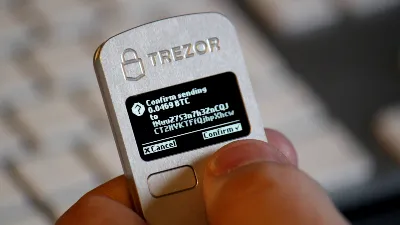KEEPING IT COLD
July 29, 2014
1BTC:$582.203400
- Artist
- Fact Date
- Fact #
- undefined
- Printing Specifications
- Paper / Stock
- Page Size
With hacks and errors depriving many crypto users of their digital currency, better custodial solutions were badly needed. In January 2014, Trezor launched the first bitcoin hardware wallet, giving users the option to keep their coins in cold storage. An entire hardware wallet industry has since spawned, with devices becoming ever more sophisticated.
As Bitcoin increased in value, so did the prevalence of hacks and user errors that led to wallets being drained or rendered inaccessible. For those with significant holdings, the safest option was what became known as “cold storage” – the practice of keeping private keys completely offline. The most common methods were paper wallets and air-gapped computers.
A paper wallet involved generating a key pair on an offline computer and printing the private and public keys, often as QR codes, onto a piece of paper to be stored in a physical safe. While this protected against remote hacking, it introduced new risks: physical damage from fire or water, theft, or loss. Furthermore, spending from a paper wallet required importing the private key into an online software wallet, temporarily re-exposing it to the very threats it was meant to avoid.
There had to be a better way of storing BTC – one that combined robust security with greater user-friendliness. That solution arrived with the development of the first cold storage solution courtesy of SatoshiLabs. The team behind the first mass-market cold storage wallet, which would come to be known as Trezor, was Marek “Slush” Palatinus and Pavol “Stick” Rusnák. The pair met at a Prague hackerspace and already had a wealth of Bitcoin experience; Slush was the developer of the eponymous Slush Pool, the world’s first BTC mining pool.

Keeping Digital Gold Cold
After cobbling together a rudimentary prototype, including a Raspberry Pi as the processor, a small display, two buttons for user interaction, and a USB port for communication, SatoshiLabs took to Kickstarter to fund production of the Trezor devices. However, Kickstarter denied their application, likely due to its connection with digital currency.
Instead, SatoshiLabs went direct to the Bitcoin community and launched their own pre-order system. In mid-2013, the website for the “Bitcoin Trezor” went live. The campaign offered two distinct versions of the device: the TREZOR Classic, featuring a reinforced-plastic case, and the TREZOR Metallic, housed in a premium, polished aluminum case. Critically, the devices were priced not in fiat currency, but in Bitcoin. The Classic model was priced at 1 BTC and the Metallic at 3 BTC.
Manufacturing proved to be more complex than anticipated, repeatedly delaying delivery. Finally, after more than a year in production, the first 1,000 units of the Trezor Model One began shipping to pre-order customers in July 2014.
The Trezor Model One was a marvel of minimalist design. Engineered to be portable, measuring just 60x30x6 mm, it weighed a mere 12 grams. The casing was constructed of a durable thermoplastic blend. Crucially, the two halves of the case were ultrasonically welded together, making it nearly impossible to open without leaving obvious physical damage, thus serving as a primary form of tamper evidence.
The fundamental security principle of the Trezor Model One is the complete isolation of the user’s private keys. Generated on the device during initialization, these are designed to never leave its secure, offline environment. All cryptographic operations occur within the confines of the device’s processor – a standard that subsequent cold storage solutions have emulated. SatoshiLabs had proven that it was possible to keep bitcoin secure without adding complexity. Ever since the launch of the Trezor Model One, cold storage has been the gold standard for custodying digital gold.
- Artist
- XXXXX
- BTC On this day
- July 29, 2014
- Market Cap
- $7,611,960,133
- Block Number
- 324,112
- Hash Rate
- 145,445.226 TH/s
- Price Change (1M)
2%
- Price Change (3M)
30%
- Price Change (1Y)
524%
